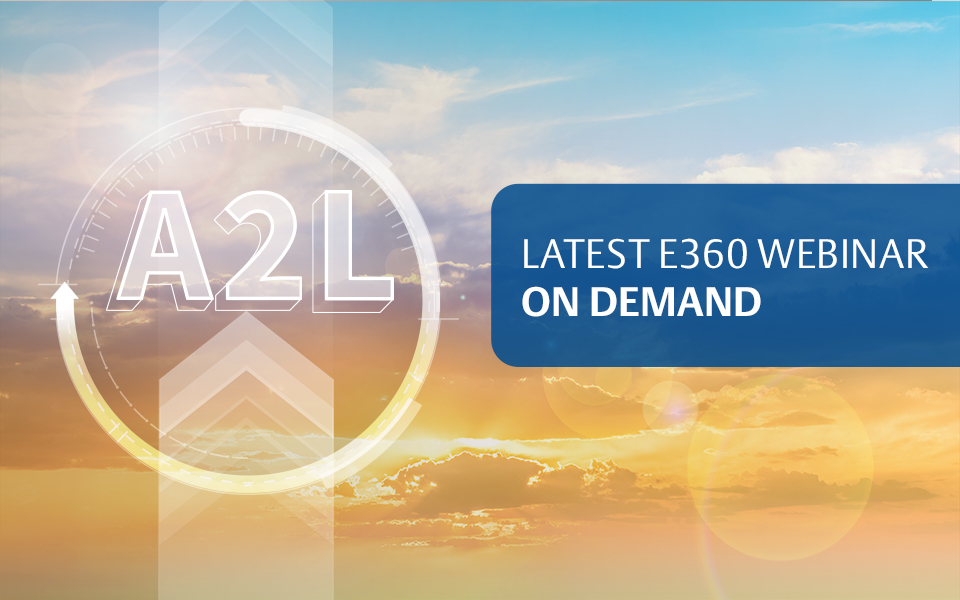*On June 1, 2023 Emerson’s Climate Technologies business became a new standalone company – Copeland. Though our name has changed, we are building on more than a century of HVACR innovation and industry leadership, and Copeland continues to offer the same products, industry stewardship, and learning opportunities you’ve grown to trust. Information found on this webpage posted before June 1, 2023 may contain our old name or branding, but you can be at ease knowing it was created with the knowledge and expertise of Copeland.
The stage is set for the emergence of A2L refrigerants in U.S. commercial refrigeration. Driven by state and federal regulations aimed at phasing down the use of hydrofluorocarbon (HFC) refrigerants with high global warming potential (GWP), A2L refrigerants offer lower GWP and high performance across a potentially wide range of applications. In the latest installment of our Journey to Lower-GWP Refrigeration E360 Webinar series, Jennifer Butsch, Copeland’s director of regulatory affairs, Mike Hill, Copeland’s system solutions architect, and I reviewed the path to A2L regulatory approval, likely A2L refrigerant candidates and A2L application safety considerations.

Regulatory approvals in progress
Because the A2L “lower flammability” classification introduces application- and refrigerant-specific charge limits as well as leak mitigation and safety management considerations, safety standard groups and regulatory agencies are currently developing guidelines for their safe use and application. As Jennifer explained in the webinar, Setting the Stage for A2L Adoption in Commercial Refrigeration, this process reflects what had previously been done for the A1 refrigerants that are currently in use.
The passing of the American Innovation and Manufacturing (AIM) Act helped to set these wheels into motion by imposing limits on HFC supplies. The AIM Act calls for a 40 percent decrease in production starting in 2024, which in turn will increase the demand for lower-GWP refrigerants like A2Ls. In response, the Air-Conditioning, Heating, and Refrigeration Institute (AHRI) has submitted proposals to establish a 150–300 GWP refrigerant recommendation for commercial refrigeration by 2026, with charge limits dependent upon specific refrigerant GWP levels — accounting for the fact that systems with higher charges can potentially leak more.
To enable the use of A2L refrigerants — and increase the current charge limits of A3 “higher flammability” refrigerants such as R-290 — modifications must be made to current safety standards, starting with the recent update to the equipment standard UL 60335-2-89. This standard establishes A2L charge limits based on the lower flammability limit (LFL) of a specific refrigerant and defines the risk mitigation requirements during installation. The 2021 update to UL 60335-2-89 was the first step in a series of approvals needed to support A2L use. Industry experts expect the balance of necessary approvals to take place soon, including:
- ASHRAE 15: commercial refrigeration update to building standards based on occupancy type
- Updates to state and local building codes
- Environmental Protection Agency (EPA) listing (i.e., approval of) A2L refrigerants
Expanded sweet spot for emerging A2L refrigerants
As I discussed in the webinar, A2L refrigerants have the potential to play a key role in a wide range of self-contained and remote systems. This is primarily due to their higher charge limit allowances and relative capacities, which enable their use in higher-horsepower (HP) applications. Generally, A2L refrigerants may be used in applications within the 0-60 HP range. This alone represents a much higher application potential than R-290, which even with the pending charge limit increase, will likely top out at the 3-4 HP range.
Copeland is currently working with three A2L refrigerants for testing and qualification across our Copeland™ compressor product lines. R-455A, R-454C and R454A — which were selected as alternatives to the common HFC R-404A — offer varying degrees of GWP (below 300 and 150 GWP), capacity and glide. Consider their characteristics:
- R-455A: 146 GWP; 8 percent capacity loss vs. R-404A; glide similar to R-448A
- R-454C: 148 GWP; 1 percent capacity gain vs. R-404A; high glide creates system design considerations
- R-454A: 238 GWP; 9 percent capacity gain vs. R-404A; glide similar to R-448A
These alternatives give original equipment manufacturers (OEMs) options for compliance, pending the EPA’s decision on listing specific A2L alternatives and their GWP limits. Note: Copeland has compressor samples available on request today, so please reach out to your Copeland sales representative for more information.
In addition to our Copeland compressor portfolio, Copeland has qualified electronic componentry for use with A2Ls, including onboard compressor protection, variable frequency drives (VFDs) and contactors. This helps to ensure proper A2L system safety protocols are in place in the event of a leak.
*The condition this was taken at was 10SST-110SCT-40RG-0SC degrees Fahrenheit.
A2L application safety
Mike covered some of the fundamentals of A2L system safety and installation, starting with an explanation about the basic differences between an A2L system and traditional HFC applications. Once defined charge thresholds are reached, a case controller will need to be installed on each refrigerated case along with a leak detection sensor mounted near the evaporator. To control refrigeration flow and mitigate potential leaks, isolation and/or safety shut-off valves (SSOVs) should be factory-installed on the outside of each case. Allowable A2L charge limits will differ, depending on whether it is an open or closed case.
Similarly, isolation valves should be factory-installed on the outside of a closed walk-in cooler box to allow for a releasable charge. However, leak mitigation strategies for walk-ins, rack rooms and outdoor condensing units are determined by a multitude of application-specific variables, including:
- The refrigeration charge and allowable releasable charge
- Square footage and/or room volume
- Room ventilation
- Air circulation via fans on evaporators
Copeland is currently enhancing its supervisory and case control features, as well as leak detection equipment to meet A2L leak sensing and mitigation requirements. To learn more about A2L regulations, refrigerant options and application safety, please view this webinar. Be sure to watch the previous E360 Webinars in our Journey to Lower-GWP Refrigerants series on our website.
Protection for high-value shipments just got even better
We’re excited to announce the release of Copeland’s newest real-time tracker, the GO Real-Time...

Three proven strategies to prevent cargo theft
The over-the-road (OTR) transport industry is experiencing a surge in cargo thefts. As thieves...

Four Keys to Successful Cold Chain Shipping
Temperature management best practices for maximizing perishable food quality and safety When...
